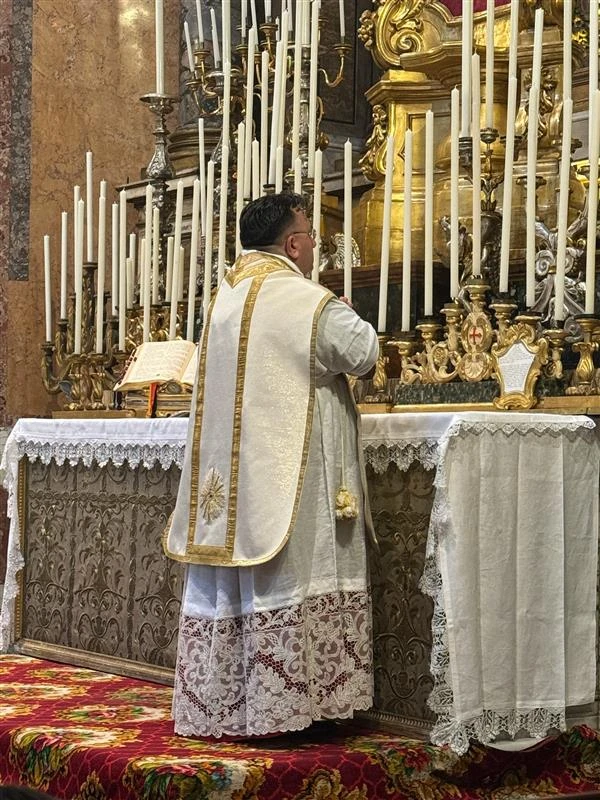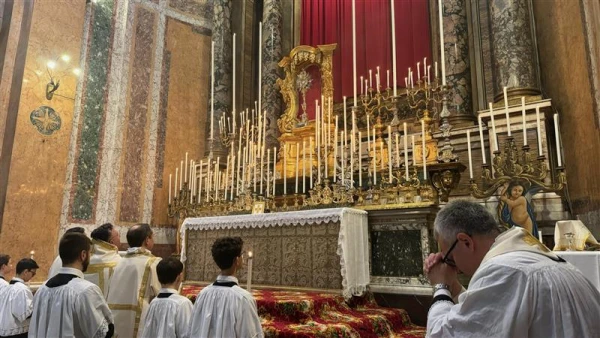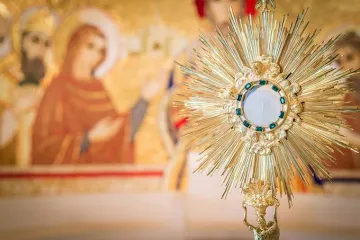Rome Newsroom, Feb 14, 2024 / 10:50 am
In the Church of Santissima Trinità dei Pellegrini, which sits in Rome’s Rione Regola neighborhood, a tradition that dates back to the 16th century lives on as a way to help the faithful prepare for the season of Lent.
The “Quarant’Ore” or “Quarantore” (“40 hours”) is an exposition and continuous devotion in front of the Blessed Sacrament where the church remains open day and night for the faithful to spend time in prayer and personal reflection.
The ceremony started this year with the celebration of a solemn high Mass on Sunday, Feb. 11, at 11 a.m. After the distribution of holy Communion, the Blessed Sacrament was exposed in a monstrance and placed in the Eucharistic throne perched above the high altar while Guido Reni’s altarpiece, dating to 1625, was covered in a red velvet tapestry.
This was followed by a procession around the interior of the church and a communal Holy Hour. The devotion ended on Tuesday at 7 a.m. with a Mass in “coram sanctissimo,” or in the presence of the Blessed Sacrament.

“At the gates of the sacred Lenten fast we are therefore happy to ensure and carry out this pious practice of prayer and reparation, in deference to the example left to us by our previous brothers and fellow citizens, and in the certain hope of one day adoring the same spotless Lamb in heaven,” the parish wrote in an Instagram post.
While there have been varying accounts as to the historical development of this devotion, there is a broad consensus among historians and liturgical scholars that it first developed in Milan under St. Anthony Zaccaria and St. Philip Neri around 1530.
By 1550 the tradition was popular in Rome, thanks to the efforts of St. Philip Neri — the founder of the Oratorian Fathers who is also known as the “Second Apostle of Rome” — and St. Ignatius of Loyola, one of the co-founders of the Jesuits.

To continue his work for Rome’s poor and to provide an example of faith and charity, St. Philip Neri founded the Confraternity of the Most Holy Trinity, which was given canonical status by Pope Paul III in 1548. In anticipation of the Holy Year of 1550, the pope suggested that the confraternity take care of pilgrims, which became one of its main duties.
Pope Pius IV in his 1562 letter lllius, Qui Pro Dominici Salvatoris Gregis officially recognized the society as an archconfraternity. It is still active today and is one of the main pillars of community life at the Church of Santissima Trinità dei Pellegrini.
While its duties included the reception of pilgrims coming to Rome and the care of convalescents, St. Philip Neri further tasked the society with practicing a monthly 40 hours of devotion.
“In the spirit of St. Philip, the main mission of the members of our archconfraternity was Eucharistic adoration,” Father Brice Meissonnier, the parish priest of Santissima Trinità dei Pellegrini, wrote to members of the archconfraternity on Feb. 10. “At the moment we no longer have the possibility to take care of pilgrims and convalescents, but we have the opportunity, at least every year, to fulfill one of our obligations by adoring the Blessed Sacrament during these Forty Hours.”

Built in 1614 over the site of an older church dedicated to St. Benedict, Santissima Trinità dei Pellegrini is a personal parish of the Fraternity of St. Peter (an Ecclesia Dei community dedicated to the celebration of the Traditional Latin Mass).
Agnese Bazzucchi, who has been a member of the archconfraternity since 2016 and currently serves as the secretary of the female members, spoke with CNA on Tuesday to reflect on the spiritual impact of the devotion both for the confraternity and for the broader Church.
(Story continues below)
🎥HIGHLIGHTS The ancient tradition of "Quarantore" devotion lights up Rome's path to Lent at Trinità dei Pellegrini Church. This 16th-century practice, beginning with a solemn Mass and 40 Hours of adoration, unites the faithful in prayer and reflection. 👉🏻 https://t.co/RLNP1VQxbC pic.twitter.com/Rv4uJMpNWz
— EWTN Vatican (@EWTNVatican) February 15, 2024
“From the moment that [St. Philip Neri] established this practice at the Church of Santissima Trinità dei Pellegrini, it became more well known around Rome and it eventually spread across all of Italy — and then of course the world,” Bazzucchi told CNA.
“And so, now, the 40 hours adoration starts on the Sunday preceding Ash Wednesday,” she said. “It is the best way to start our Lenten season, as it is a way of taking time to reflect and to be in the presence of Our Lord. So for me, and also for all our conferes, it is an amazing opportunity to grow in the faith.”





